The Original SEIKO World Time
Model No. 6217-7000
The 1st Series SEIKO World Time was a special edition to commemorate the 1964 Tokyo Olympics.
This is the inaugural version of the SEIKO World Time!
It was first released to coincide with the Tokyo Olympics in 1964.
Production ran from March through November of 1964, and again for a few months in 1967.
A dolphin case back version of this model was produced in December of 1964.
Twenty six (26) reference cities were included on this first model, with twenty five (25) timezone markers (twenty six including the International Date Line marker).
Paris and Rome are the only reference cities to share a timezone position.
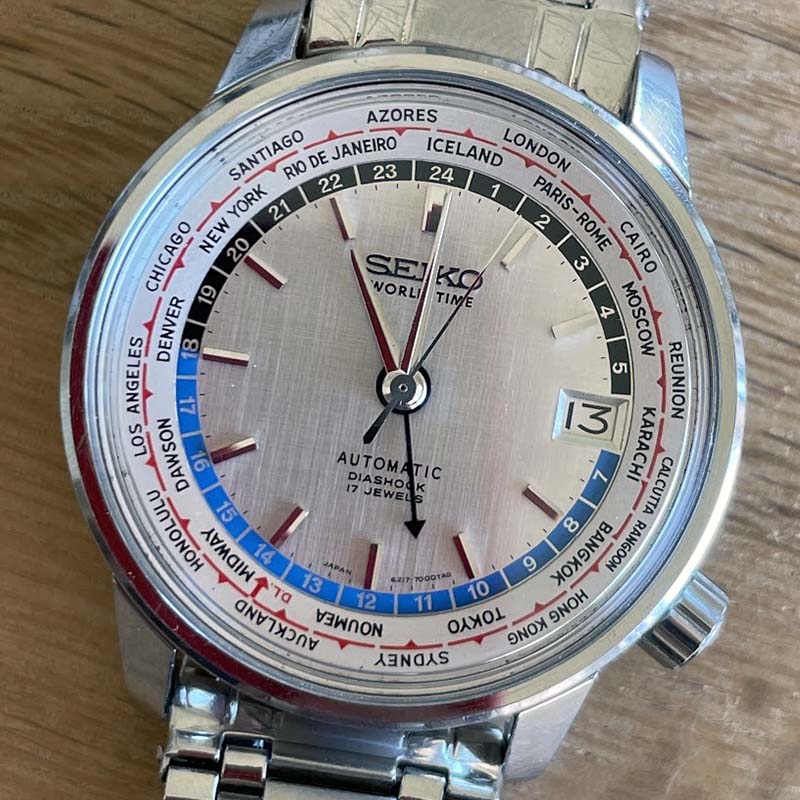
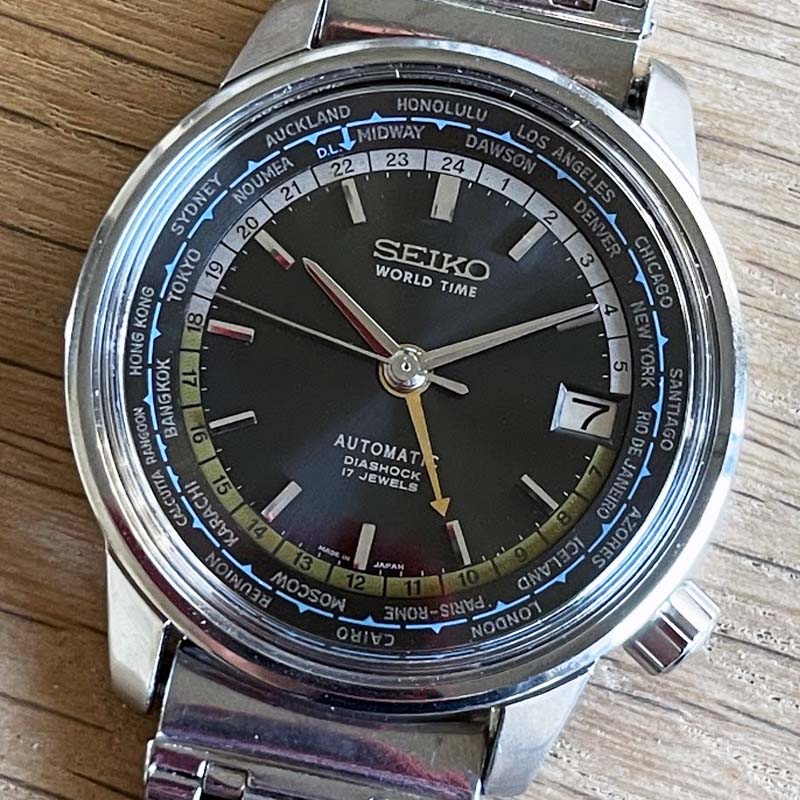
Table of Contents
- Key Statistics
- How-to Use
- Top Line Sales Info
- Original Features (that remained unchanged)
- Measurements
- The Case
- The Dials
- The Bracelet
- Different Case Backs
- Different Markings Inside the Case
- Estimated Total Production of the 1964 Olympic Torch Version
- Tips on Confirming Originality
- Resale Value
- The Dolphin Case Back
- The 1967 Olympic Torch (Re)production
- Related Articles
Key Statistics
37.5mm
Watch Case Size w/o Crown
43mm
Lug to Lug Measurement
Uncommon
Rarity Index Among Cataloged Examples is 5.4 out of 10
215
Total Examples Cataloged
26.8%
Percentage of all Cataloged Mechanical Examples
How to use
To use the world time complication: start by making sure the crown is in the first position (pushed all the way in).
In this position, turning the crown will rotate the inner bezel of reference cities in either direction.
Locate the reference city representing your current timezone and rotate the bezel until the GMT / 24 hour hand is pointing directly at your reference city.
The bezel is now correctly aligned so that each city marker indicates the current time for that timezone, using the 24 hour ring on the dial.
For example, say you are in New York, it is 3pm and you want the time in London.
Rotate the inner bezel so that the GMT hand is pointing at New York.
This should put the New York timezome marker at the 15 mark on the 24 hour ring.
Now find London, and note that it is next to the 20 marker, indicating it is 8pm in London, 9pm in Paris/Rome, etc.
Top-line Sales Info
- 37.5mm stainless steel case
- In-house movement: 6217A – 17 jewel automatic, 2.5Hz / 18,000 bph
- Date display at 3-o'clock w/ quick change at second position of the crown
- Waterproof to 30m
- 2-way Diashock protection
- Offered in silver linen and black sunburst dial options with applied indices
- MSRP of 12,000 YEN, $59 USD
- Included 6 month warranty against manufacturer defects
Original Features (that remained unchanged)
While the SEIKO World Time did change several times over the years, many key features remained common throughout all versions. These include:
- The crown cannot be used to wind the mainspring. Either keep the watch on a winder, or just shake it around a few times, set the time and wear it.
- Crown placement is at 4-o’clock
-
Crown functions by position
- rotates internal cities bezel
- date quick-set
- sets the time (4th series models have hacking seconds)
- Date window at 3-o’clock
Measurements
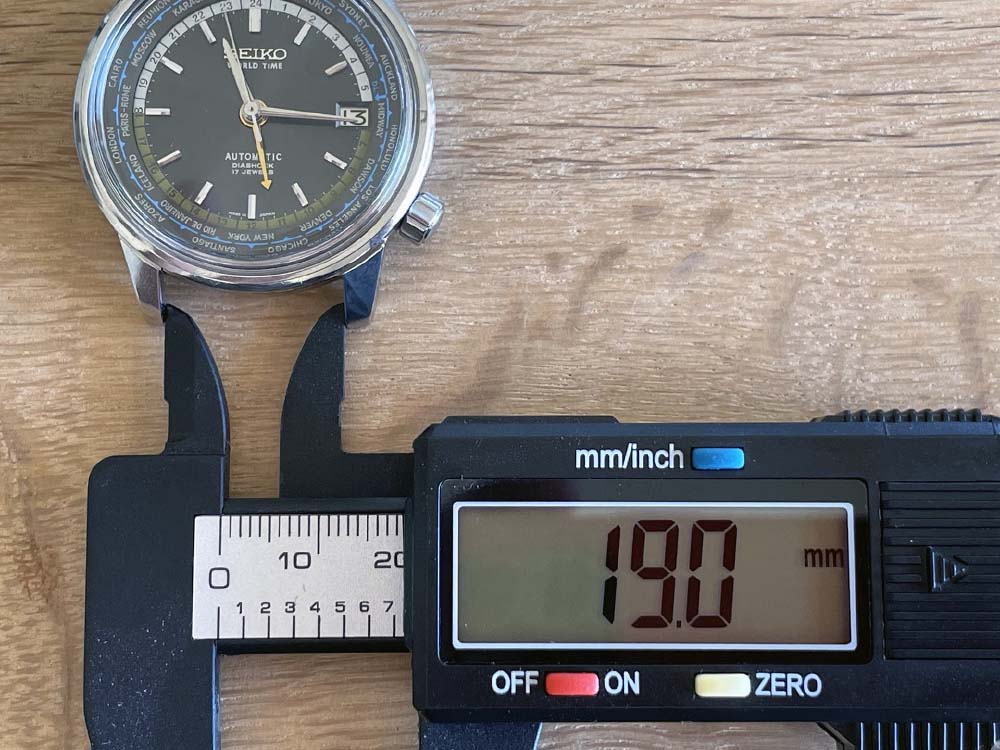
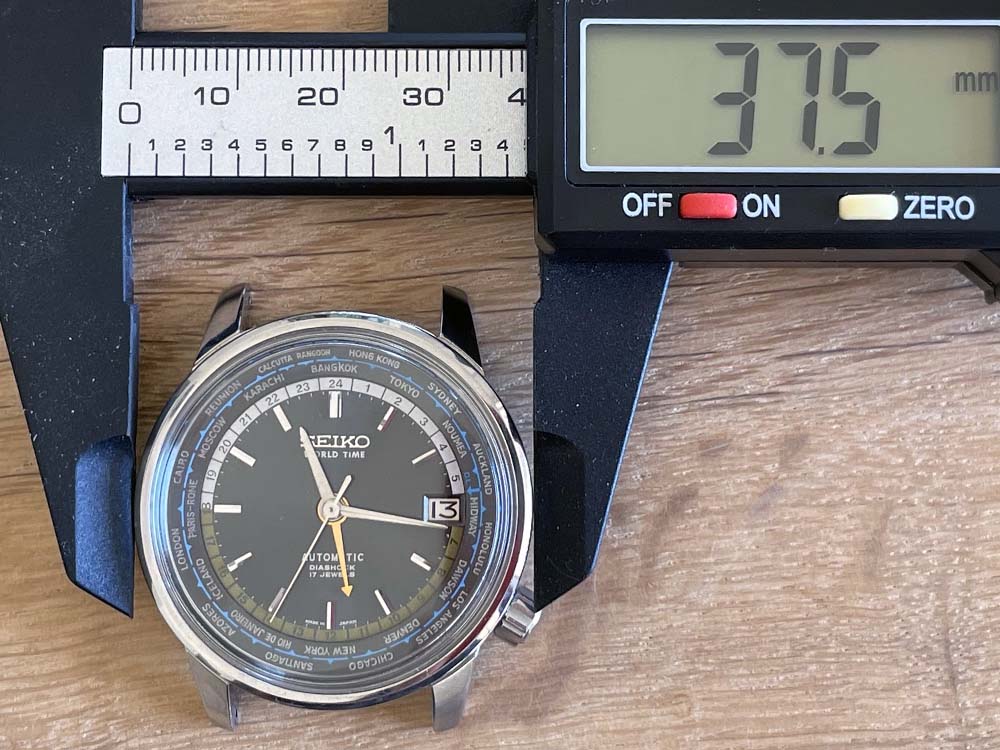
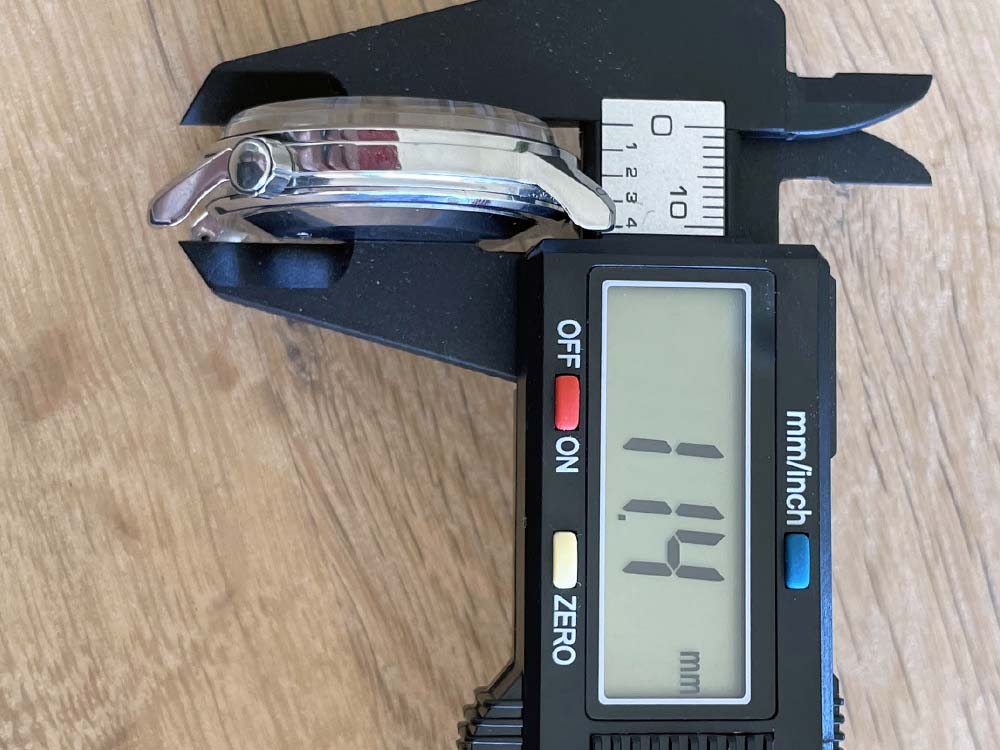
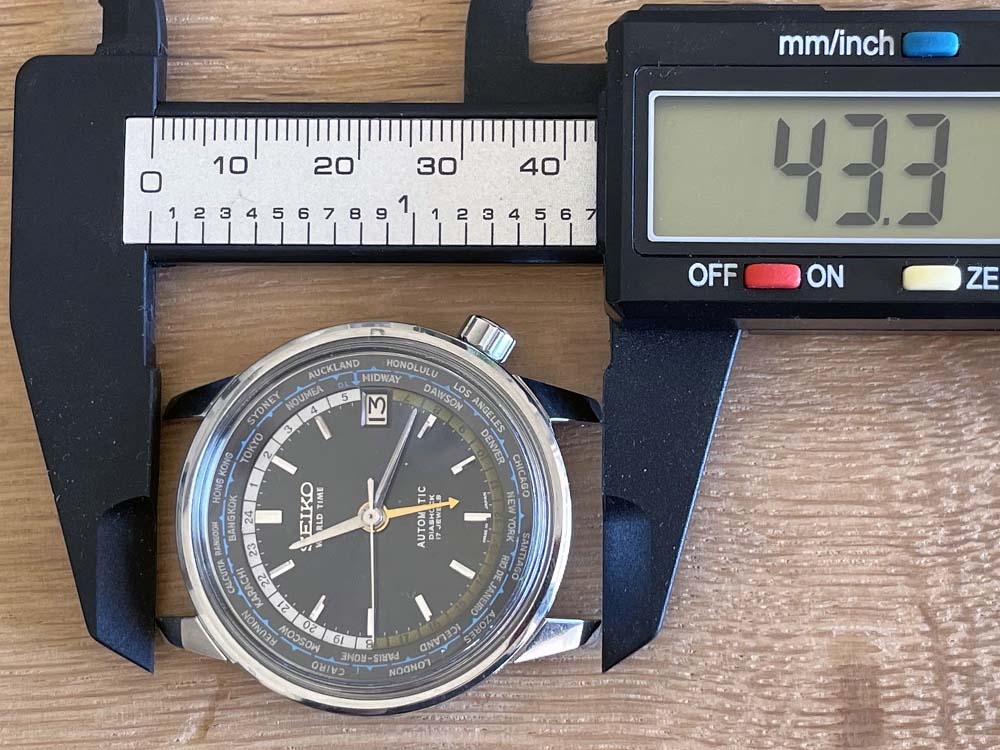
- 37.5mm case
- 19mm lug width
- 43mm lug to lug
- Stainless Steel, polished
- Fluted Crown
- Snap-on case back
The Case
The case is stainless steel with a polished finish on all surfaces and a snap-on case back with etched model attribution.
The lugs curved down for a clean look, sitting flush with the case back when placed on a flat surface.
The crown stuck out prominently at the 4-o'clock position.
Note: It is not uncommon to find pitting and/or fine hairline cracks on examples that spend a lot of time around water or in humid climates.
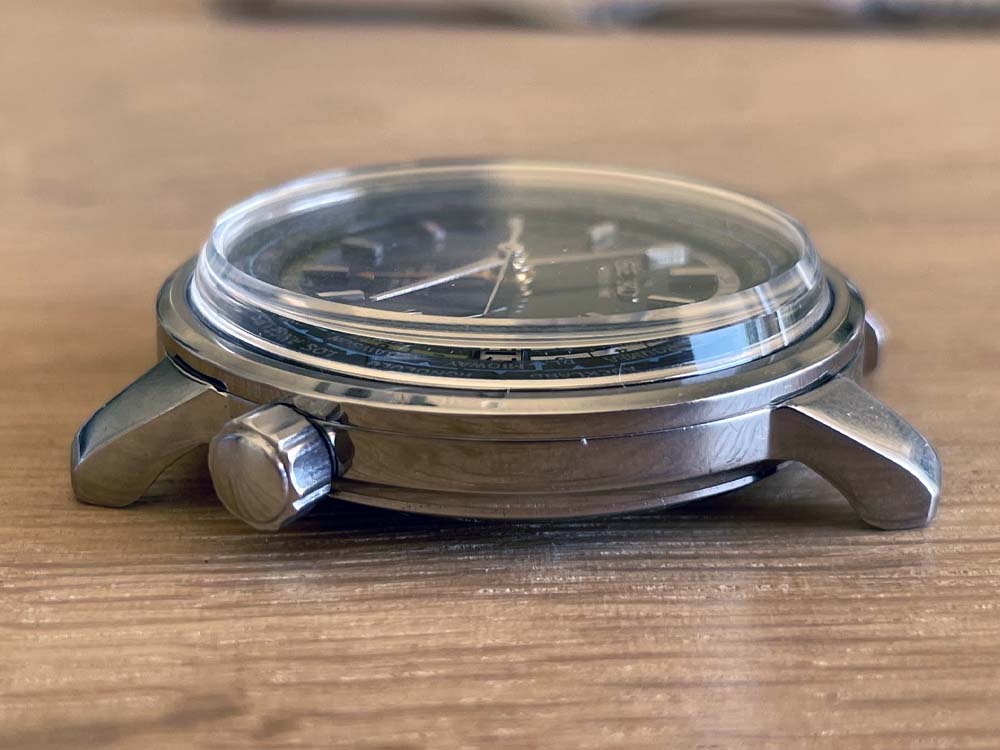
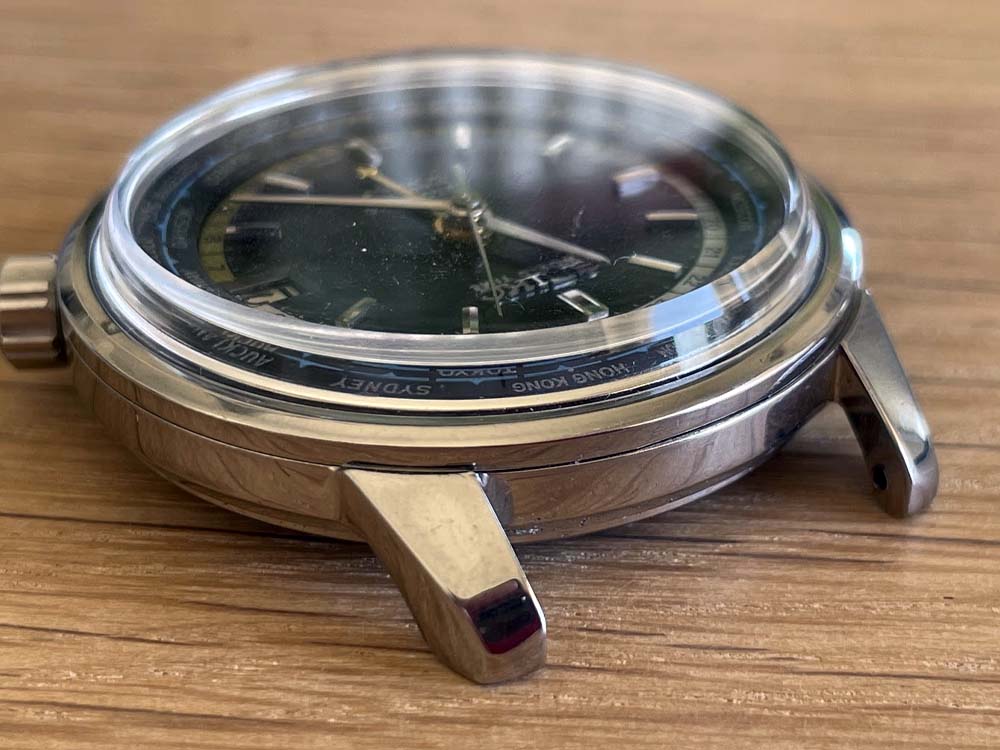
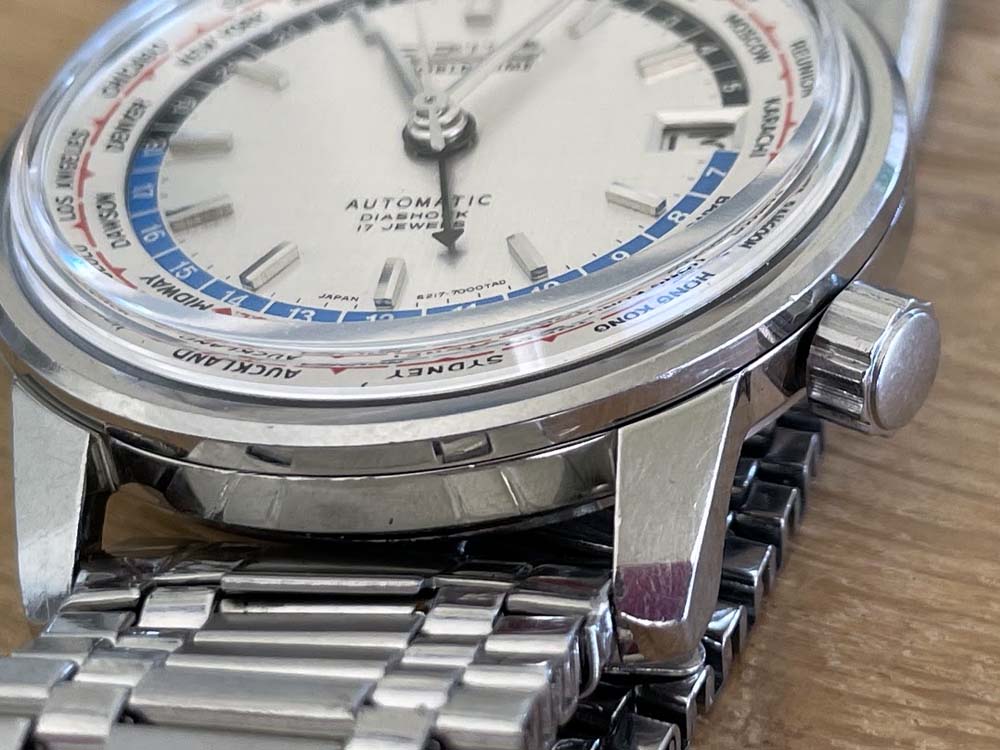
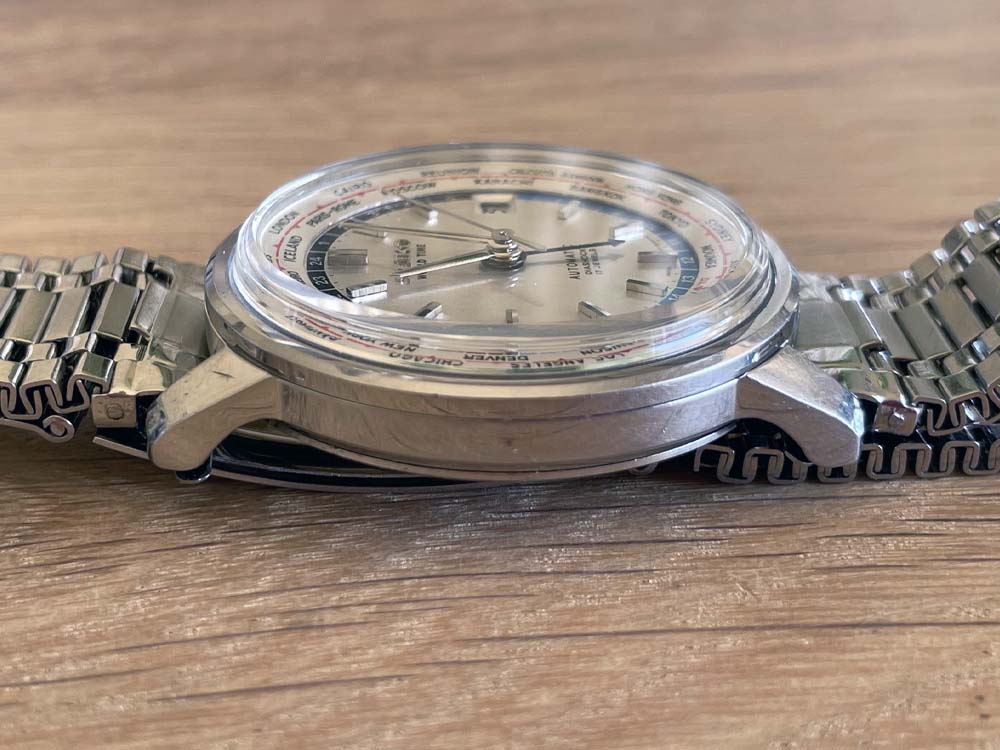
The Dials
Here are the 4 original dials, in two colors: silver (with linen texture) or black (with radial sunburst texture). Each dial color has two dial code variations. The JAPAN | 6217-7000TAD dials appears later in the 1964 run, and are much less commmon in general.
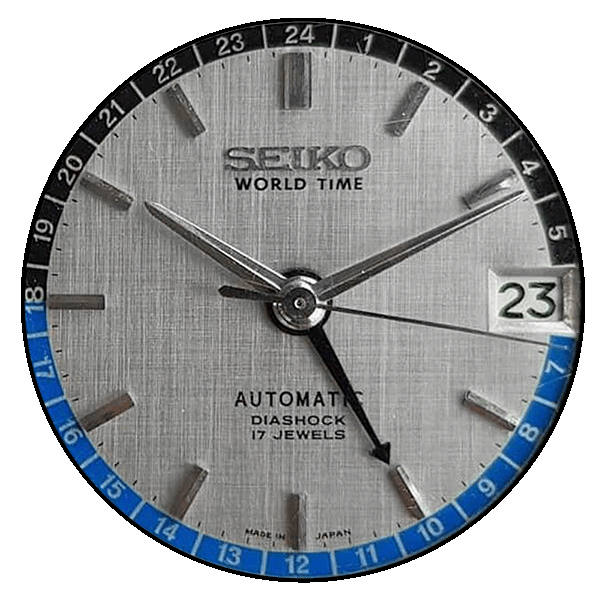
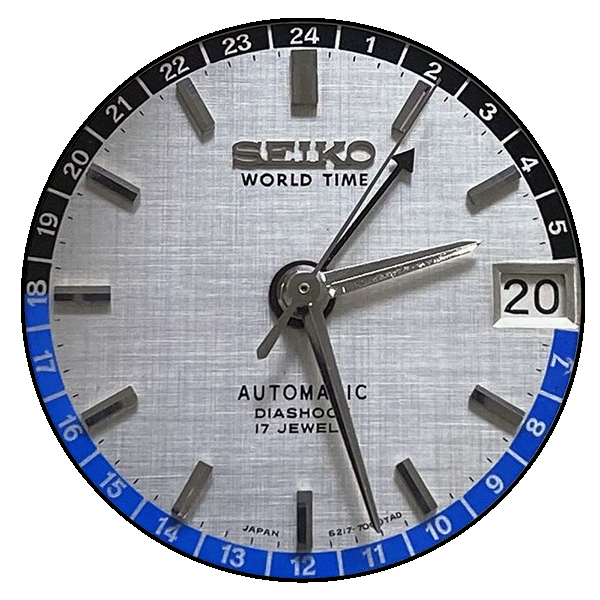
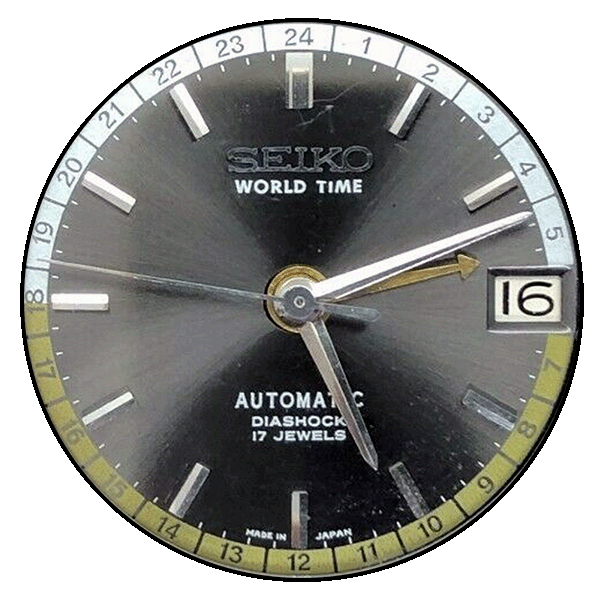
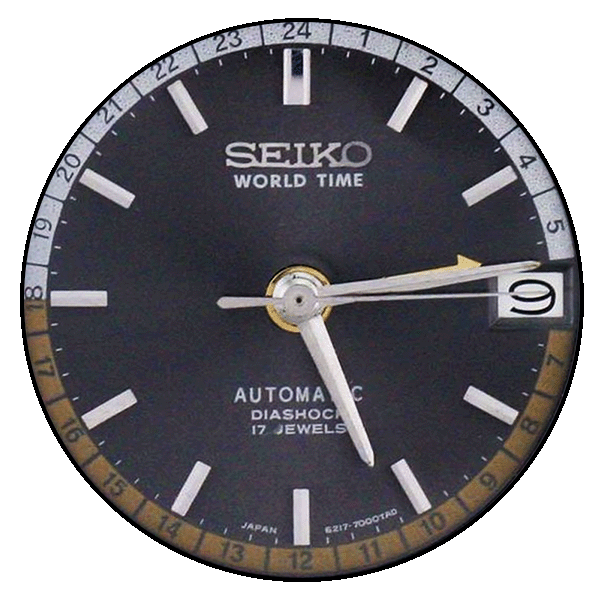
Despite the use of "T" in some of the dial codes, which is commonly used to indicate the use of Tritium lume, there is no lume on the dial or hands of this watch.
Instead, the "T" used on vintage Seiko dials like this one indicates that the dial was manufactured in the "Hamazawa Kogyo Chino Plant".
Of the dial options, it appears that 82% were produced with the silver dial, with 17% being produced with black dials.
This is based on data collected in the Image Data Study.
Here are some more dial photos:
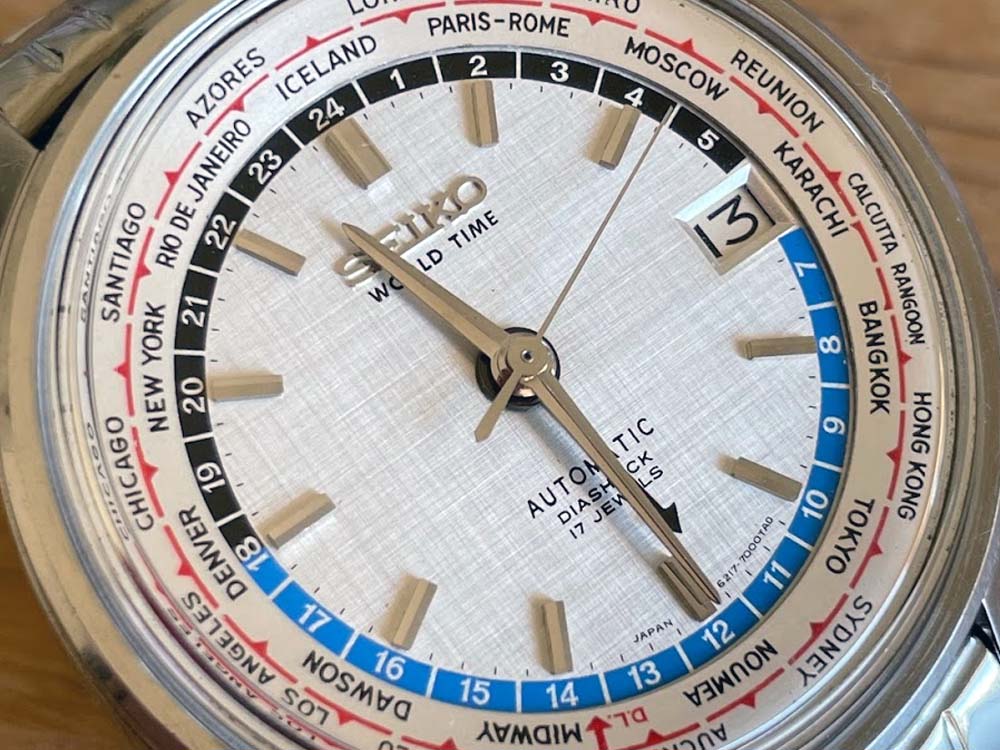
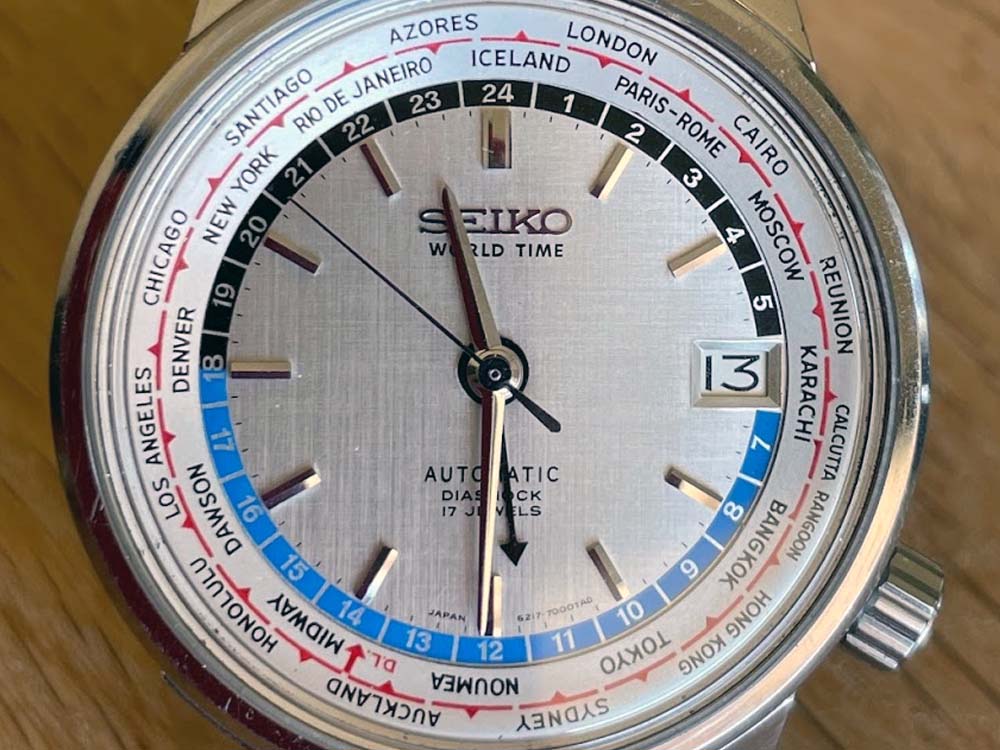
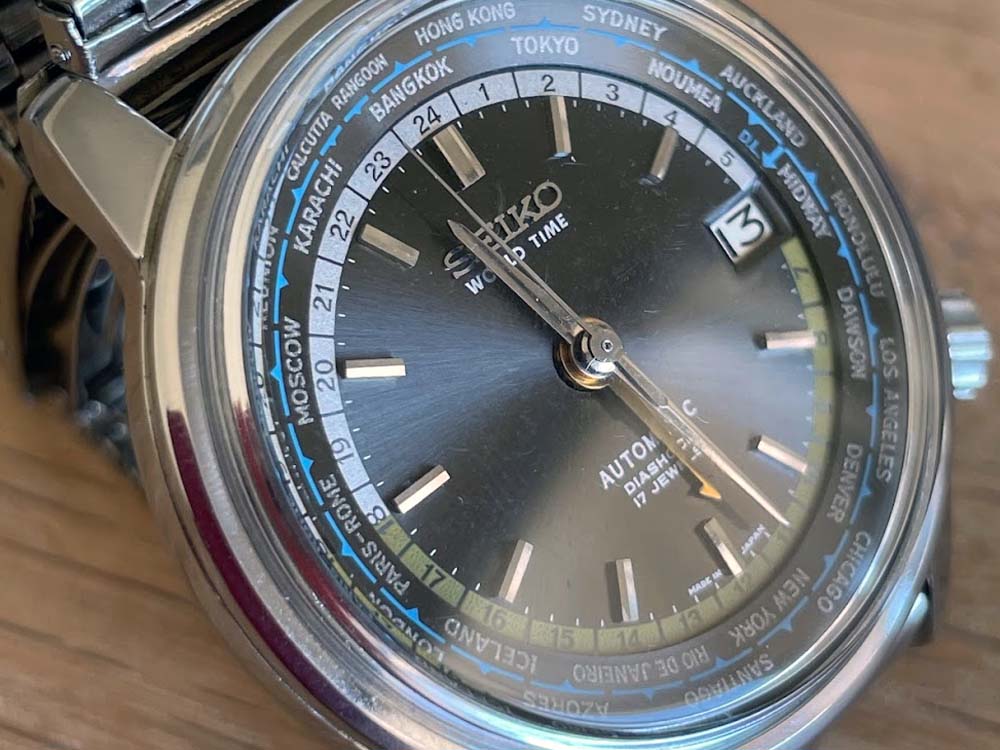
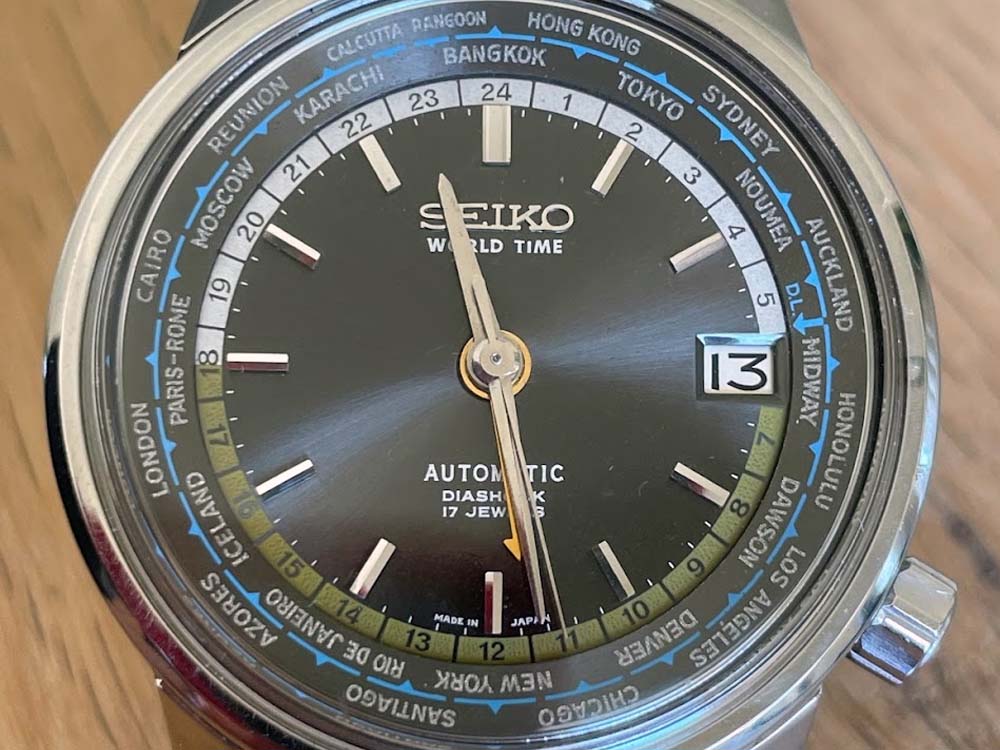
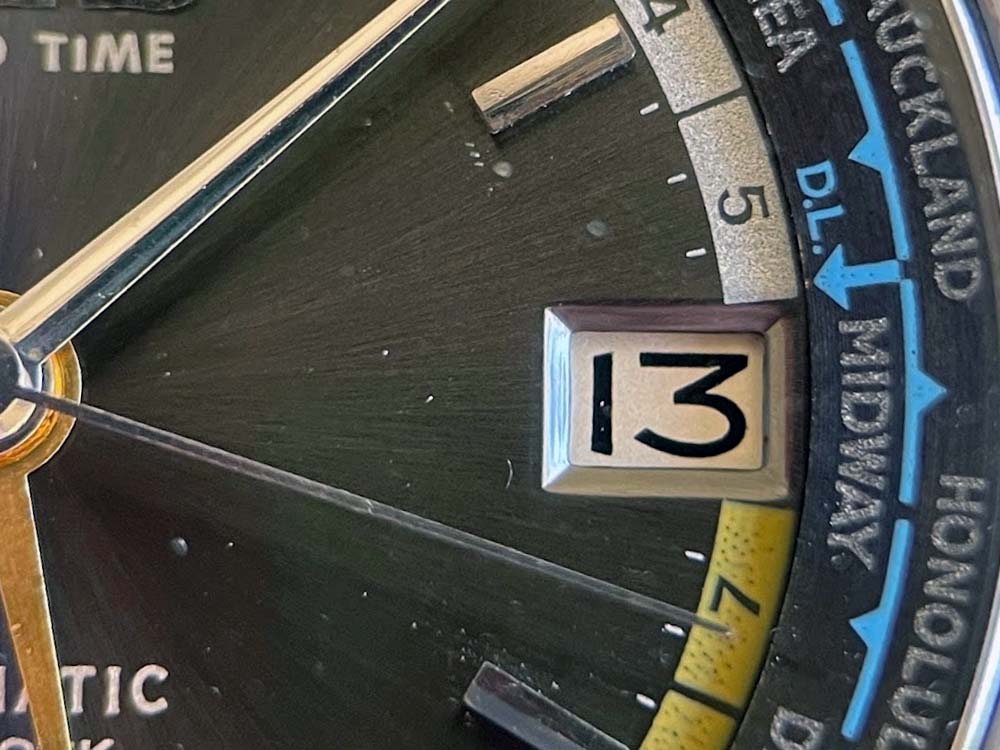
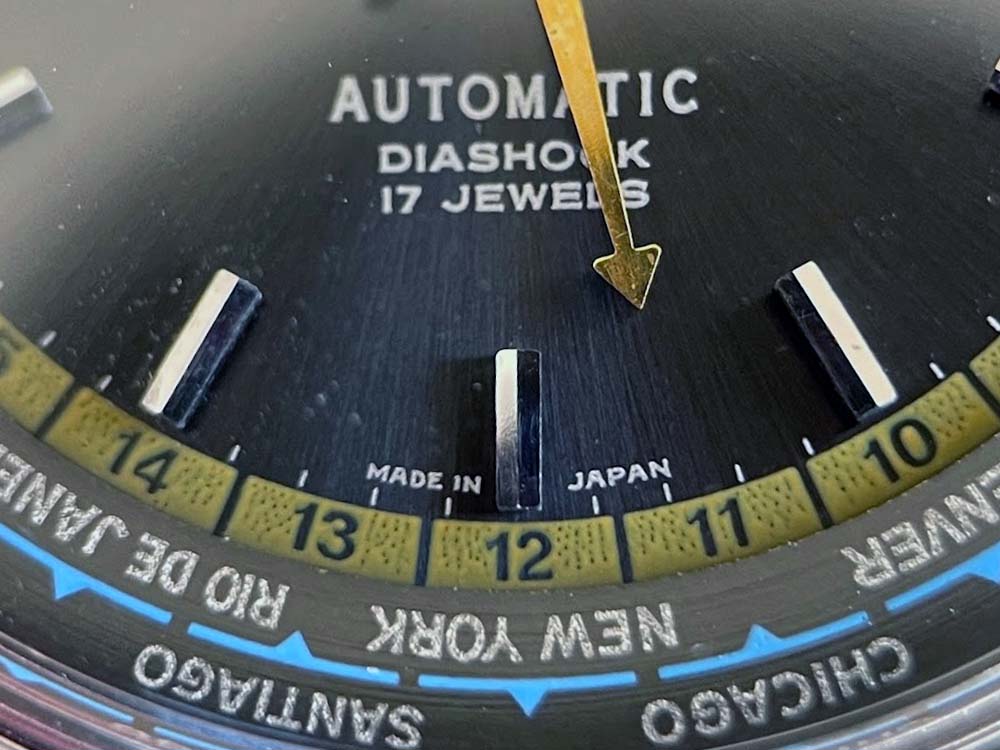
The Bracelet
This watch was offered in a number of bracelets (more on that in the article on validating this model). The most common was the tank tread bracelet, shown here.
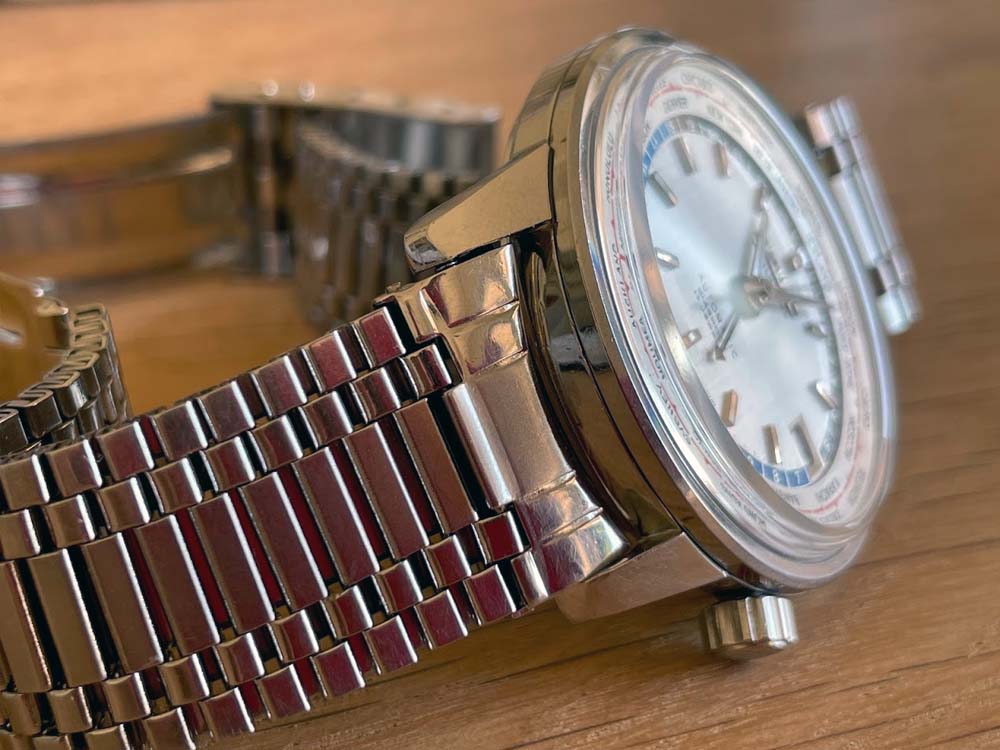
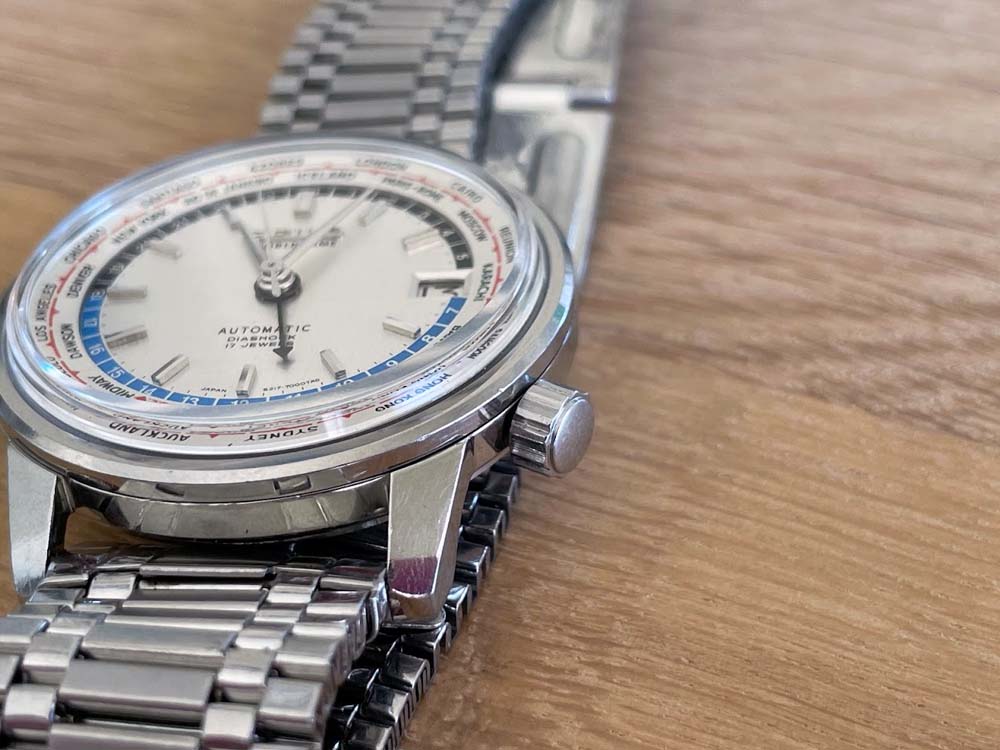
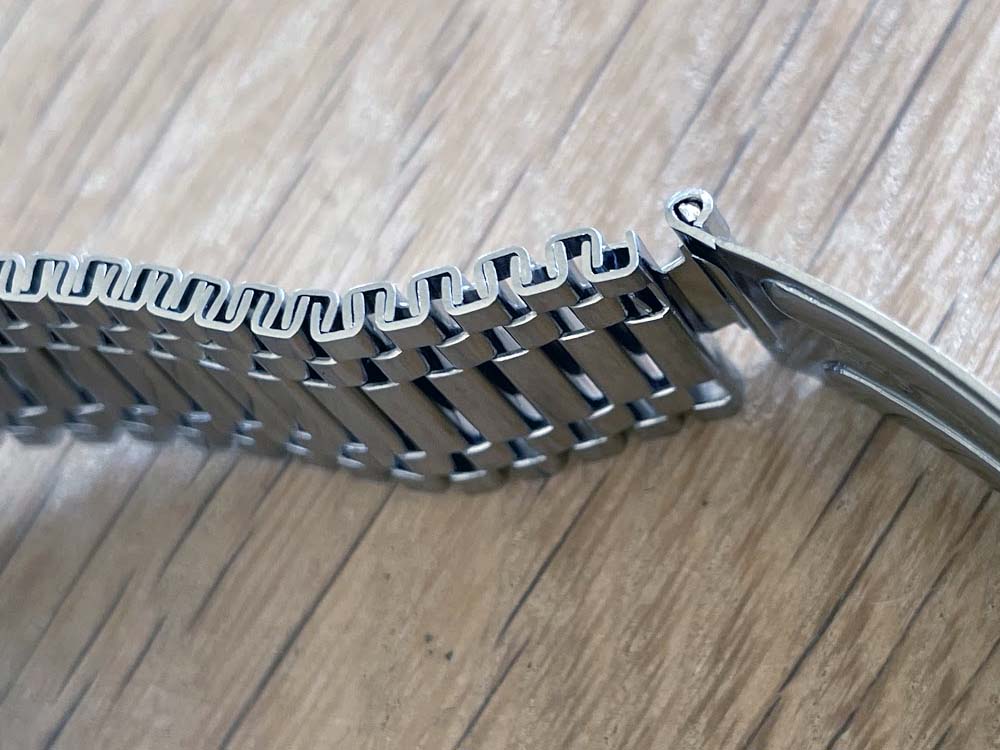
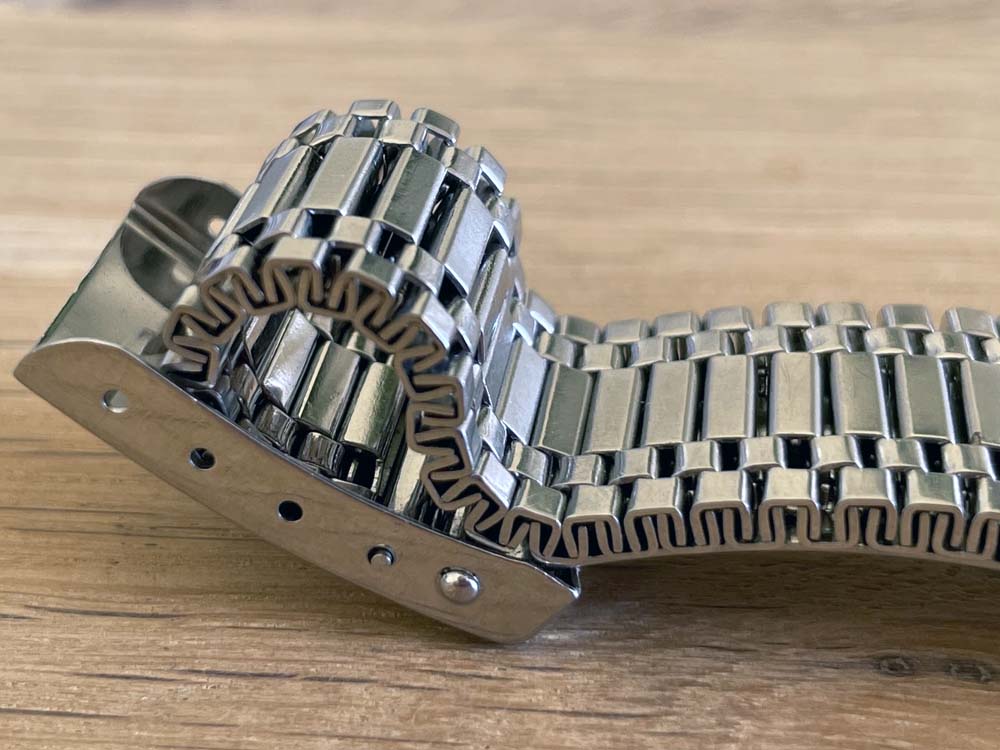
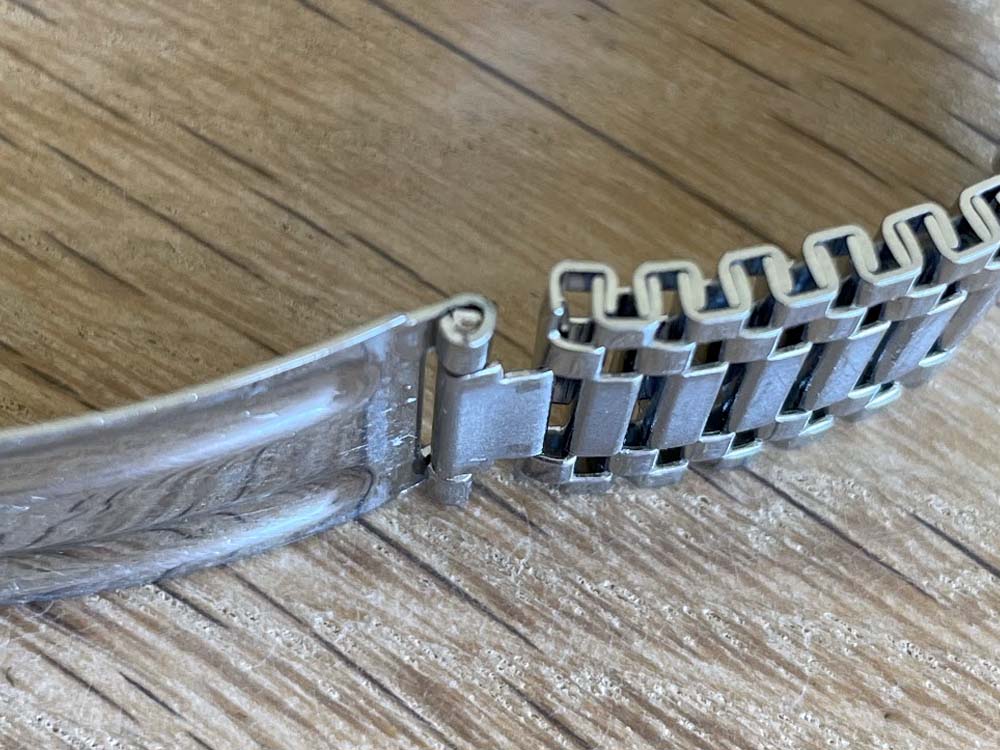
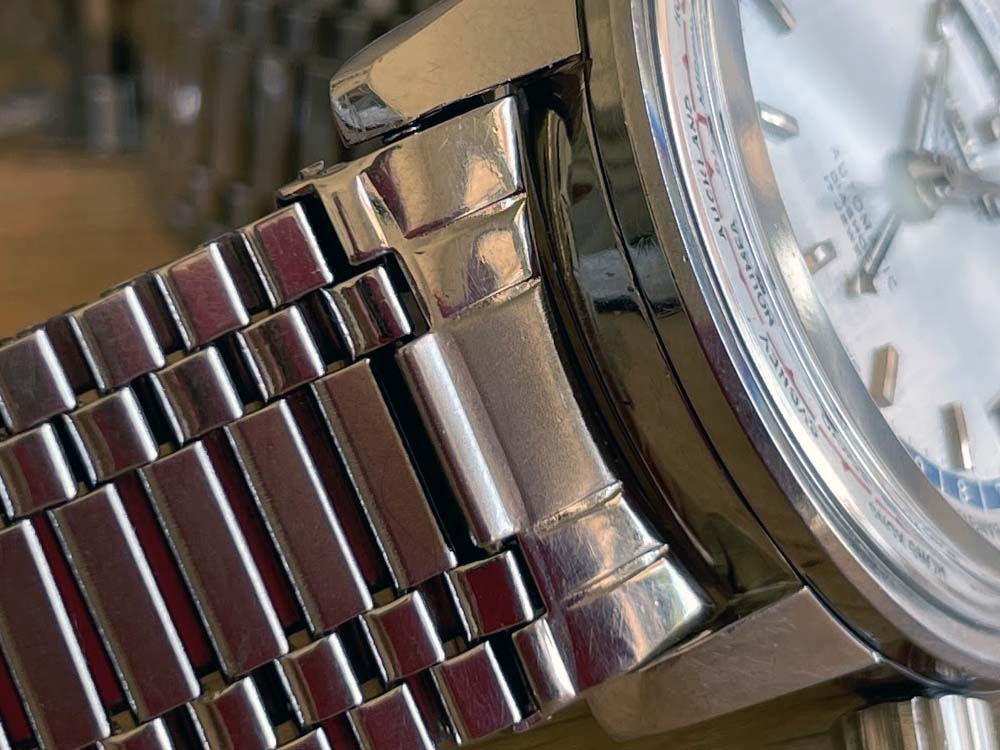
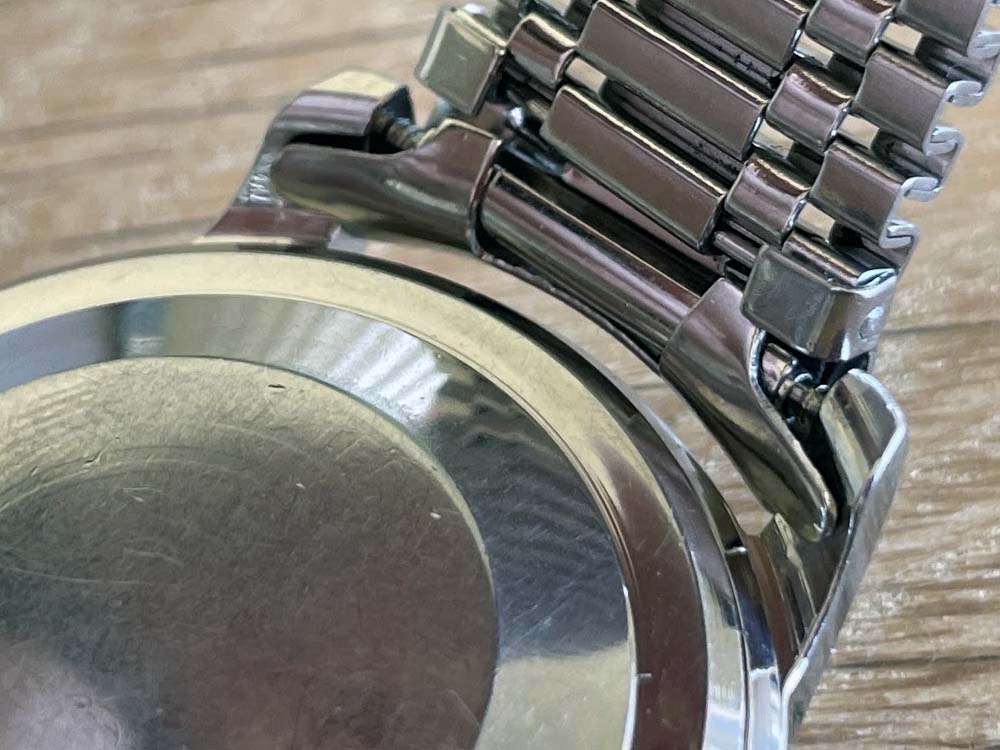
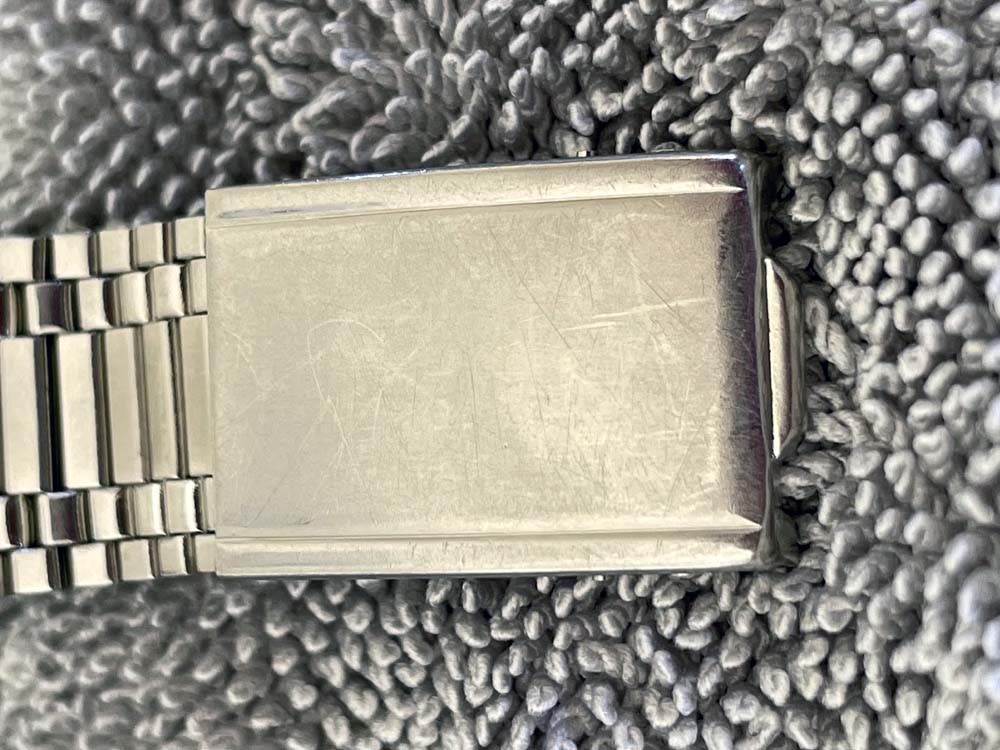
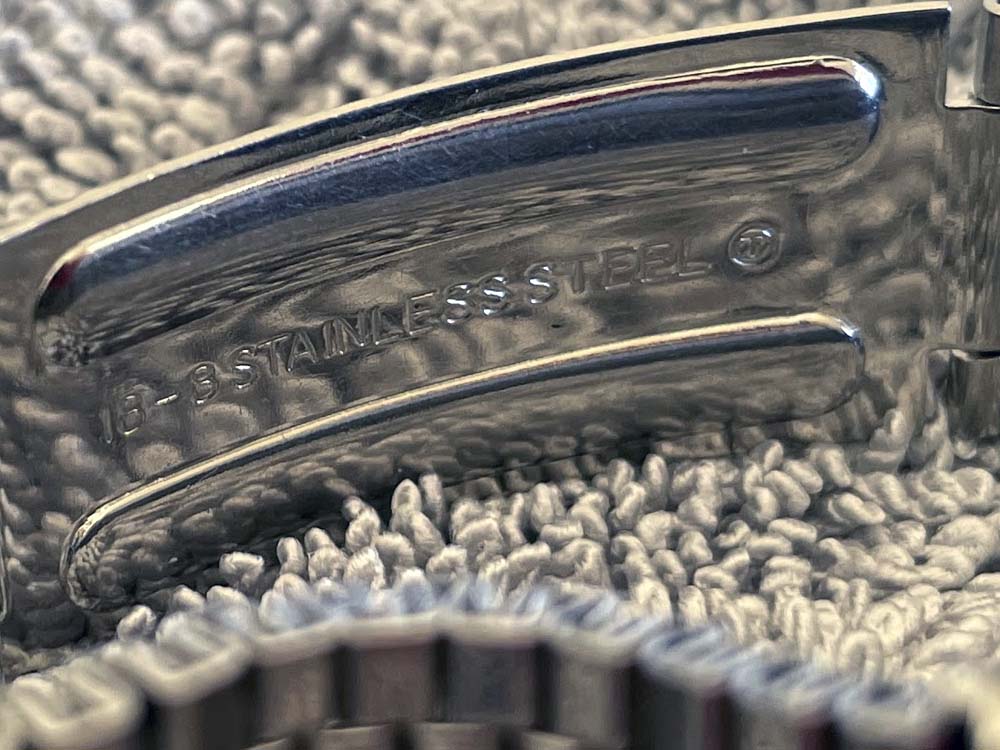
Different Case Backs
Small changes were made to the way the case back design was applied. Early versions had an etched case back that was easy worn off. An updated case back with a deeper etching or stamped version appeared later in the 1964 production run. And in 1967 an engraved case back was used.
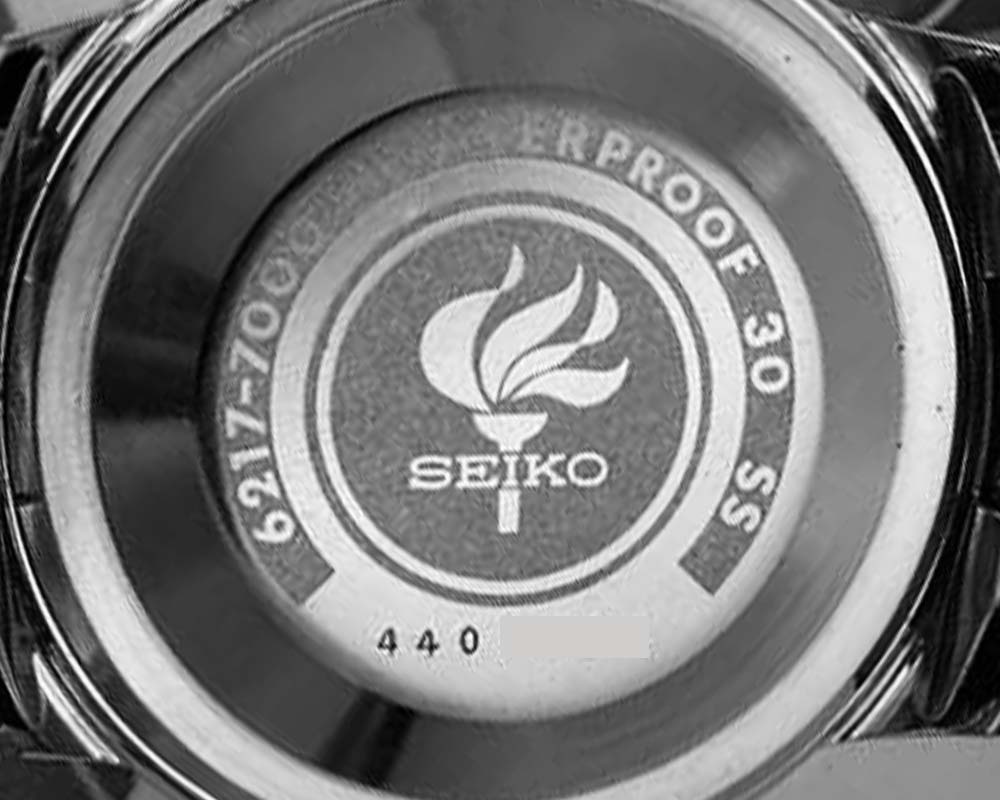
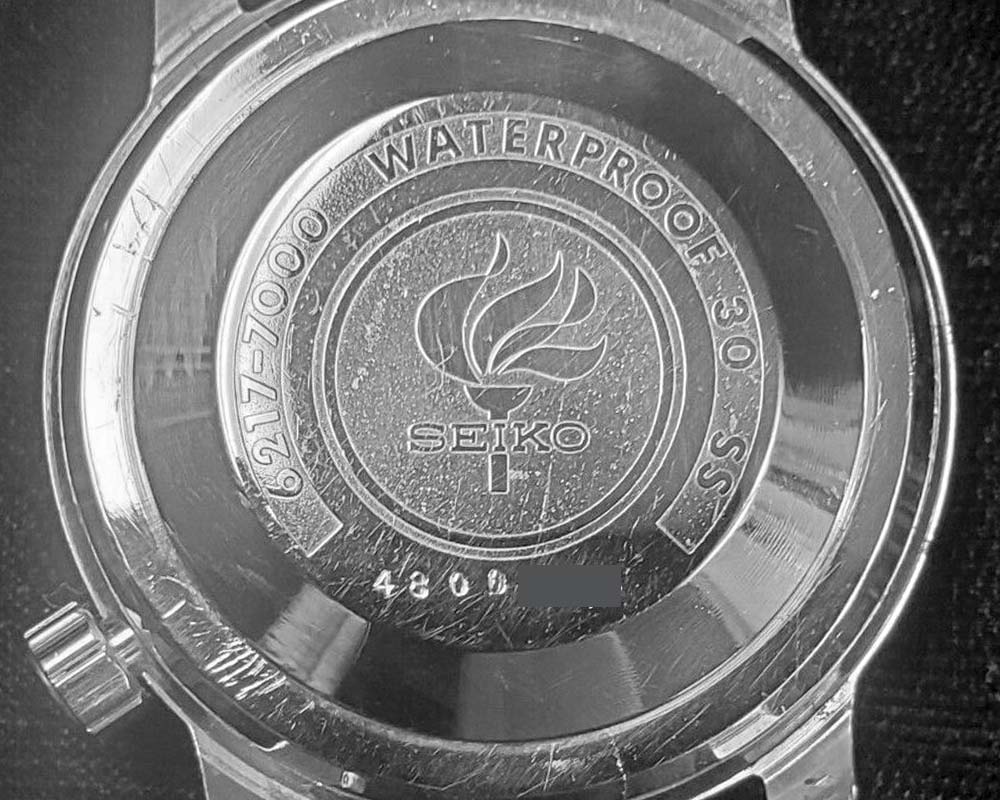
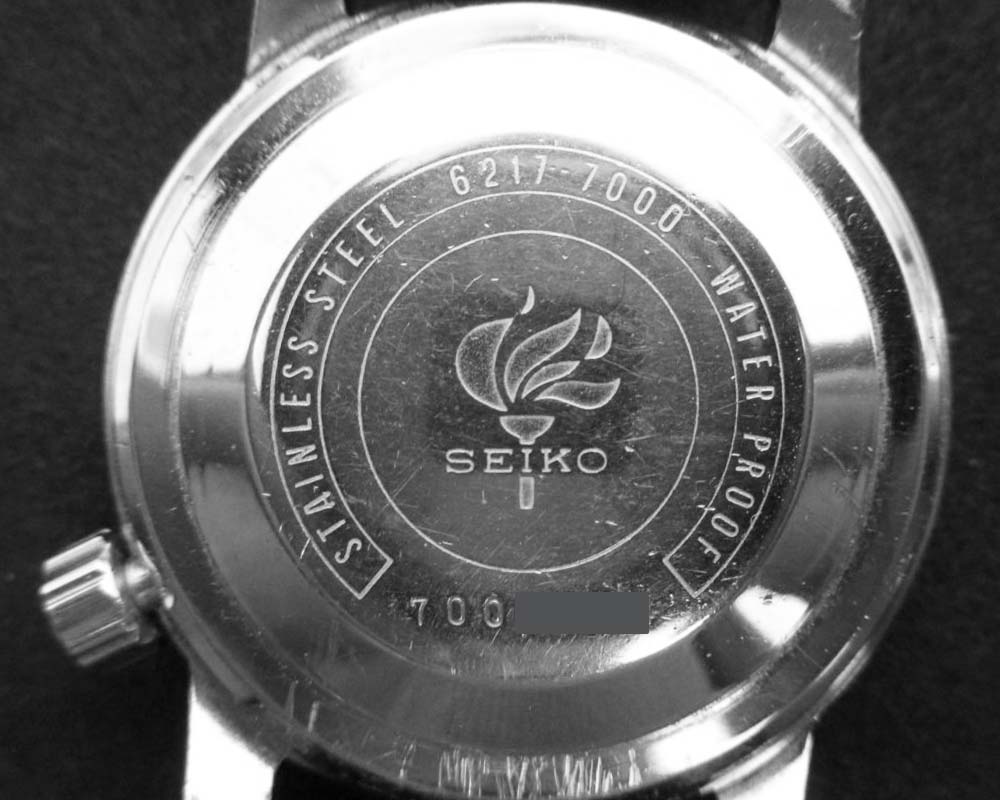
Here you can see what the etched case back looked like new, vs worn down
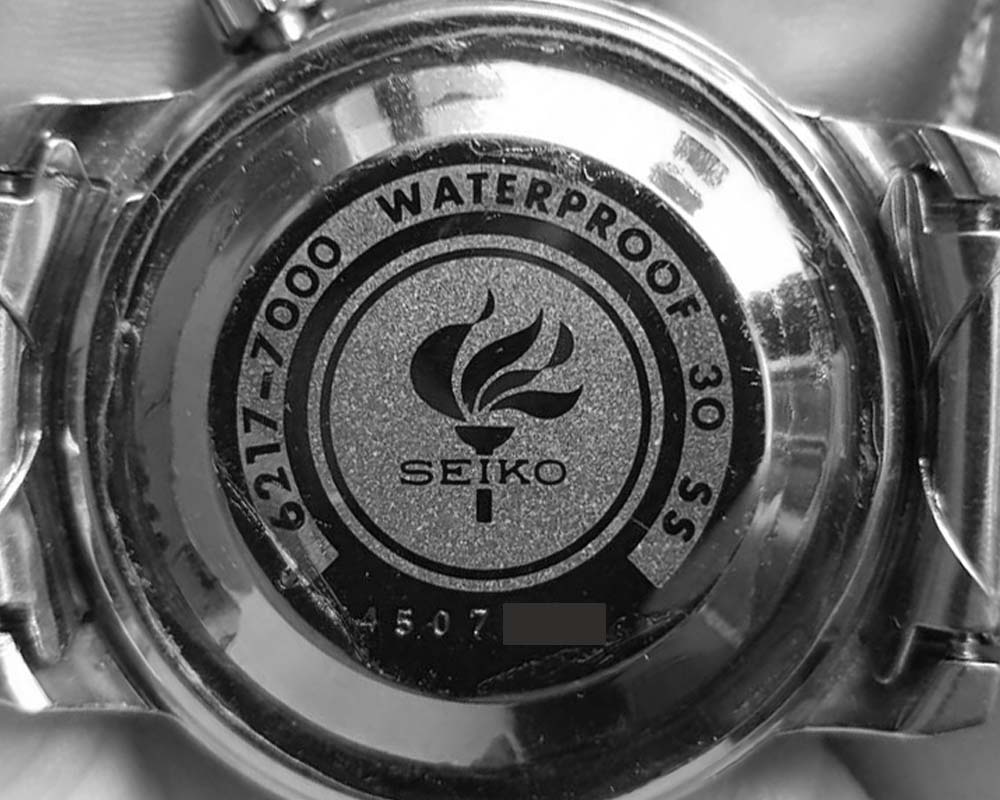
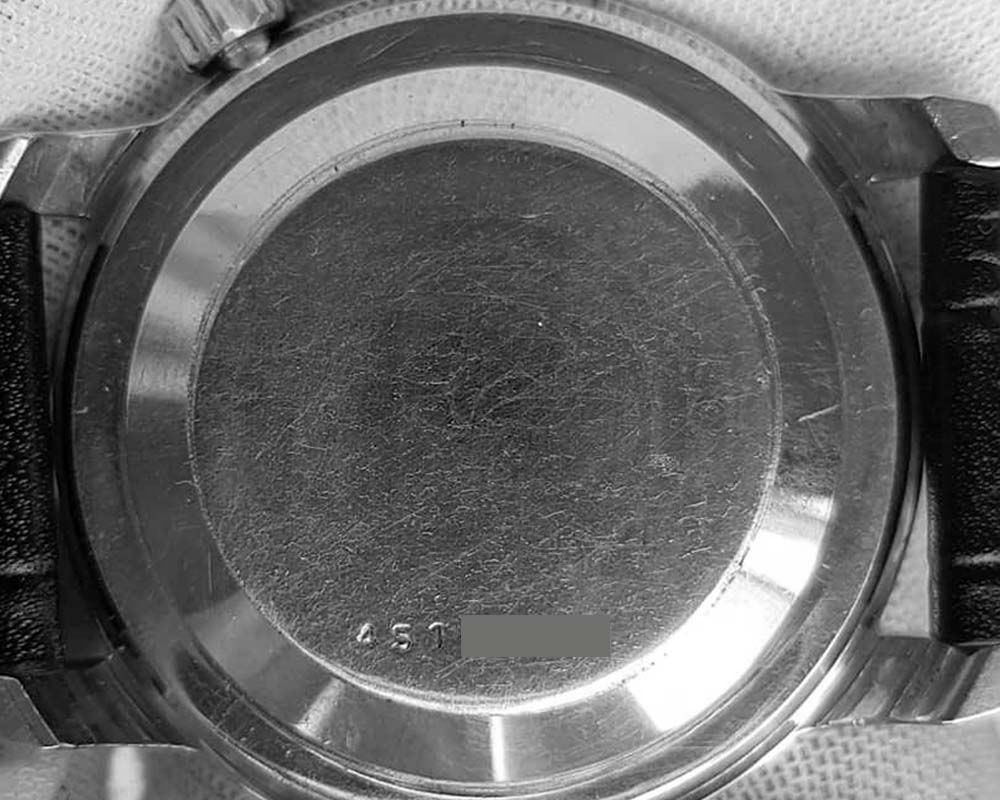
Different Markings Inside the Case
There are at least a couple differences in the markings on the movement and the inside of the case back.
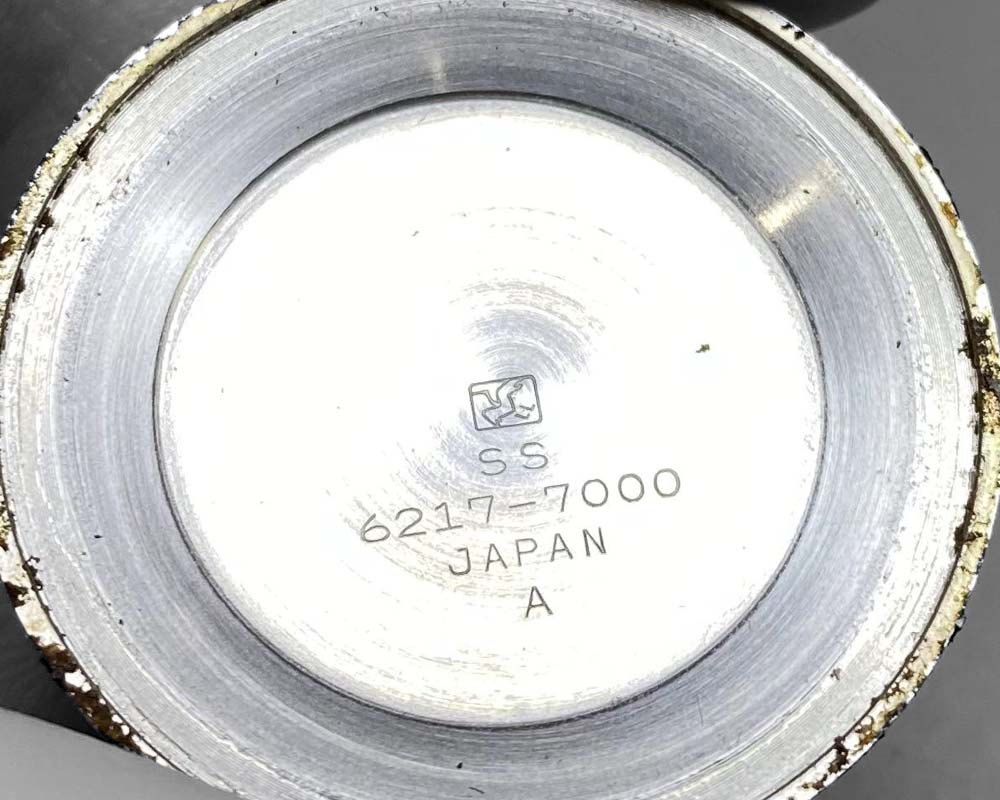
SS
6217-7000
JAPAN
A
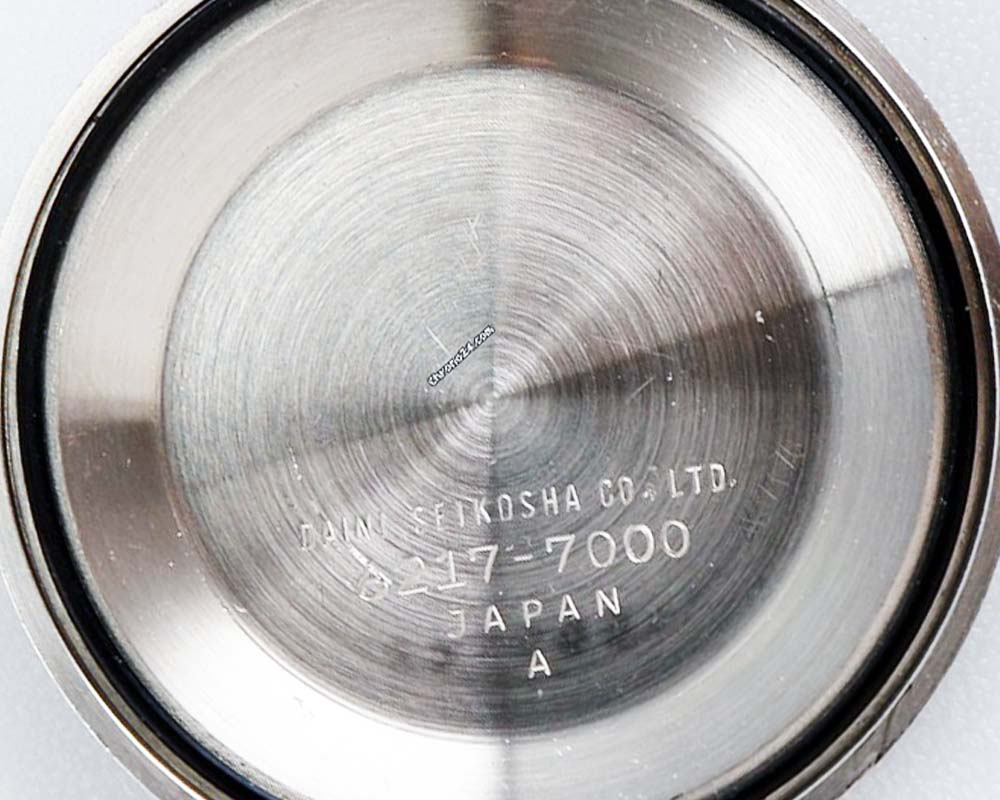
DAINI SEIKOSHA CO. LTD.
6217-7000
JAPAN
A
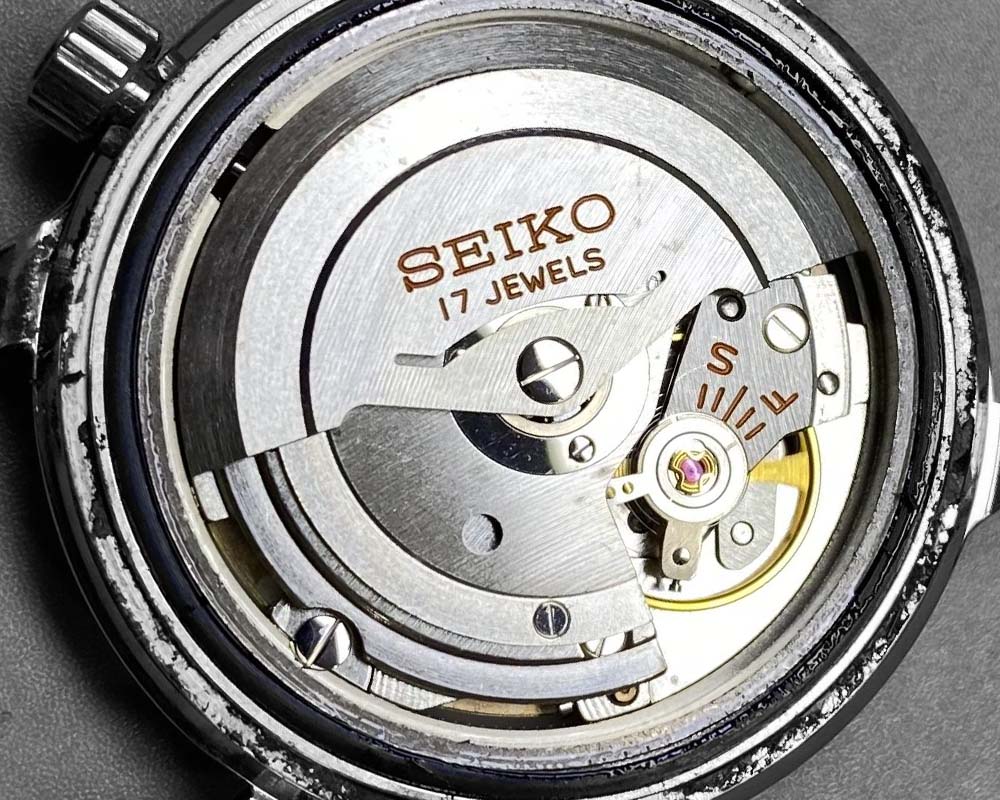
SEIKO
17 JEWELS
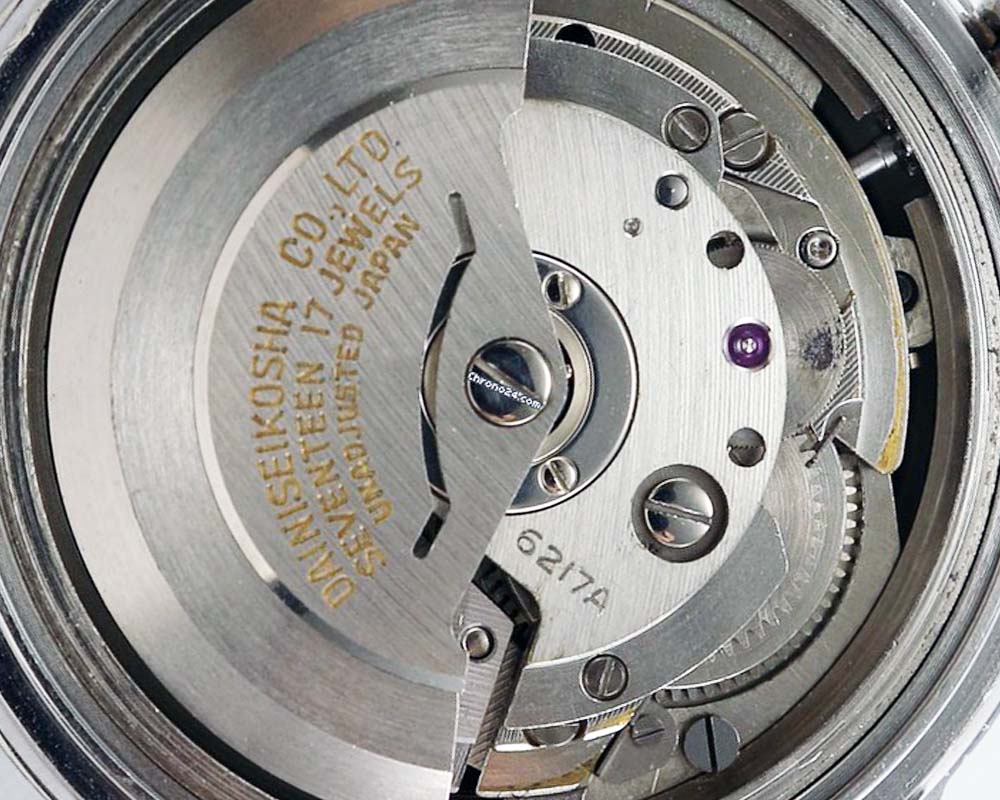
DAINISEIKOSHA CO.,LTD.
SEVENTEEN 17 JEWELS
UNADJUSTED JAPAN
Estimated Total Production of the 1964 Olympic Torch Version
This model had a 7-digit serial number scheme, allowing for up to 99,999 watches to be produced each month.
It was produced from March through November 1964.
This gives us a maximum production of 899,991 watches.
And while we do see several production months move above 10,000 total watches, none go much beyond that milestone.
Based on current data, at least 95,209 were produced in 1964.
Tips on Confirming Originality
This series was produced in high quantities relative to its short (9 month) production run.
As of this writing, it is the second most commonly found vintage SEIKO World Time listed for sale, after the 6117-640X models.
Follow the link below for more information on confirming originality of the 6217-7000.
Resale Value
Please note:
- This scale is a derivative of the Hagerty Classic Car Condition Rankings, adapted for watches. It is an attempt to keep it simple. They explain it really clearly here (albeit in car terms): Car Conditions: What The Numbers Mean.
- Almost no one owns or has even seen a condition 1 example of this watch in at least a few decades. Most of what is sold online today are condition 4 and 5 watches - if you think you have a gem, it is most likely a 3.
- While many enthusiasts spend inordinate amounts of time chasing down the best deal, digging through the dark corners of the internet, local antique shops and estate sales, and are ok fixing things up themselves... a lot of others would like to just know what a clean example is worth from a reputable source - that's what these are. Think of them as the price you would expect to pay if you saw one of these under the glass at your favorite local watch shop.
- All values assume OEM parts or all original examples. After market dials, mismatched bracelets etc will reduce the value, in some cases substantially. For example a non-original bracelet can reduce the overall value by 10-20%, a non-original dial may reduce resale value by 80% or more.
- Finally, gold-tone variations (these are not gold plated, but rather gold colored base metal) command a much lower resale value, from 50% to 80% less than equivalent examples in stainless steel.
| Rank | Description and Value |
|---|---|
1 |
Condition 1
A perfect original (NOS) that has been professionally serviced and where all components are functioning as new; also a watch that has been restored to current maximum professional standards of quality in every area, showing no signs of wear; a 95-plus point show piece that isn't worn.
|
2 |
Condition 2
Well-restored or a combination of superior restoration and excellent original, where any replacement parts are strictly OEM; also, an extremely well-maintained original showing very minimal wear, or NOS that has not been professionally serviced.
|
3 |
Condition 3
Completely operable original or "older restoration" showing wear; also, a good amateur restoration, all presentable and serviceable inside and out. Plus combinations of well-done restoration and good operable components or a partially restored watch with all parts necessary to complete a restoration and / or valuable NOS parts.
|
4 |
Condition 4
A wearable watch needing no work to be functional; also, a deteriorated restoration or a poor amateur restoration. All components may need restoration to be "excellent", but the watch is usable "as is".
|
5 |
Condition 5
Needs complete restoration; may or may not be running, but isn't rusted, wrecked or stripped to the point of being useful only for parts.
|
6 |
Condition 6
May or may not be running, but is weathered, wrecked and/or stripped to the point of being useful primarily for parts.
|
The Dolphin Case Back
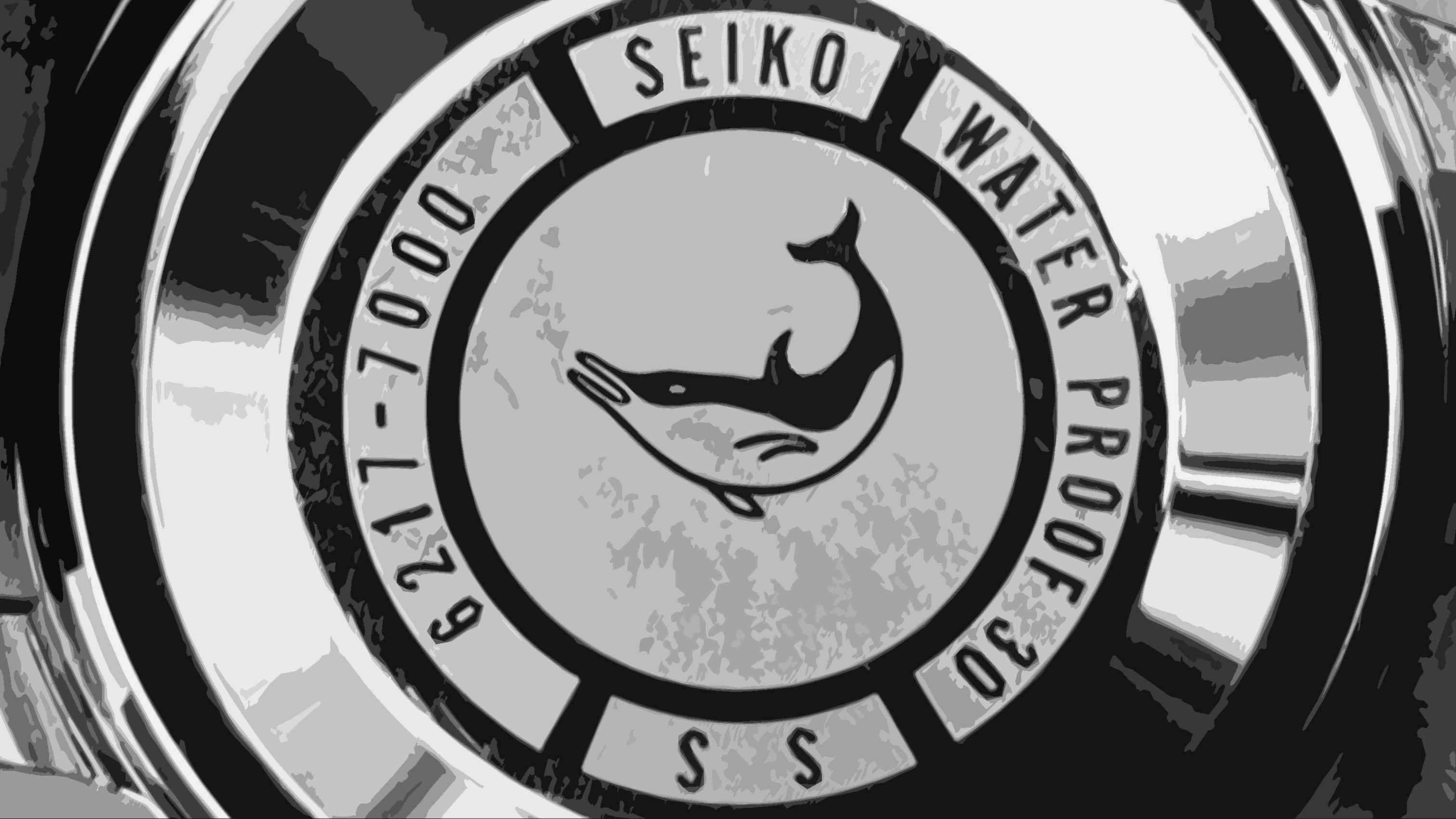
There is a rare version of the 6217-7000 that had a dolphin case back.
Based on the Image Study data, this watch appears be a December 1964 producton uniquely.
Read more about it here:
The 1967 Olympic Torch (Re)production

The 6217-7000 was again produced in limited quantities in 1967.
Read more about it here:
Related Articles

Authenticating The Seiko World Time 6217-7000
Tips on confirming the originality of your Seiko World Time 6217-7000
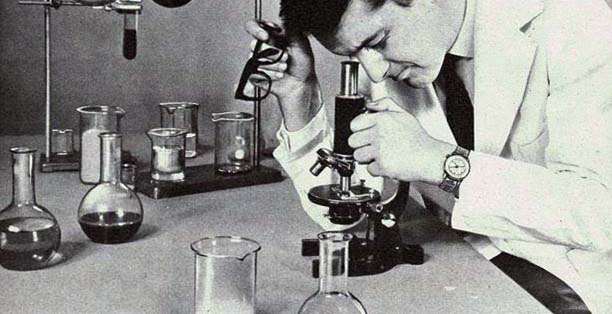
Old Ad Scans: Seiko World Time 6217-7000
A small collection of ad and catalog scans of the SEIKO World Time 6217-7000

The Seiko World Time 6217-7000 - The Dolphin
All about the Dolphin World Time watch from SEIKO, December 1964
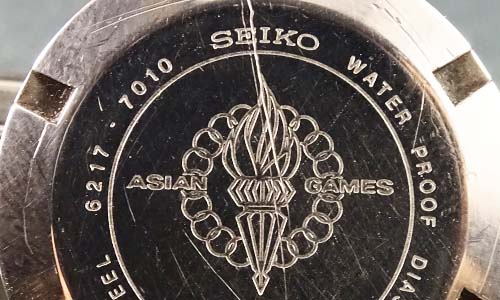
The Seiko World Time 6217-7010 - Asian Games
All about the Asian Games World Time watch from SEIKO, August 1966
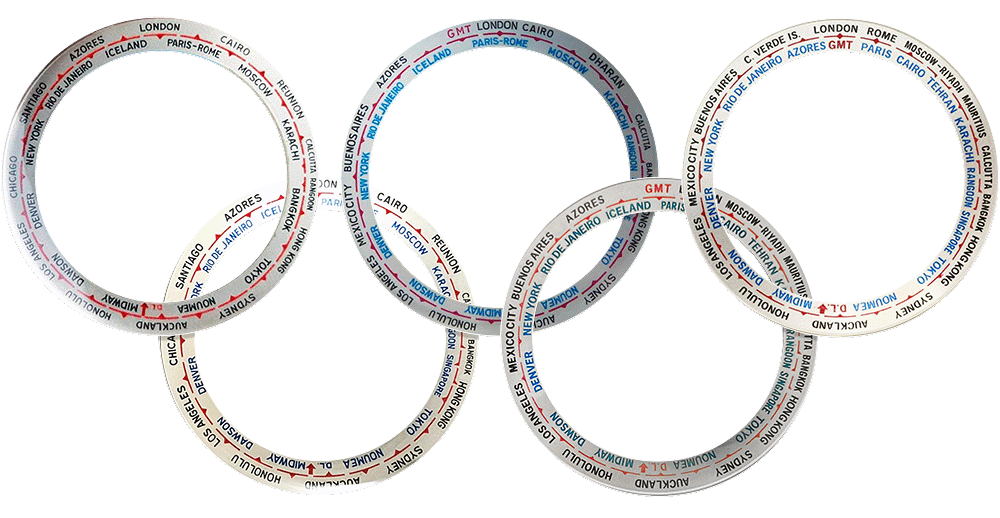
Reference Cities - Changes over the Years
A history of changes to the Cities Bezel on SEIKO World Time mechanical watches from 1964 through 1976
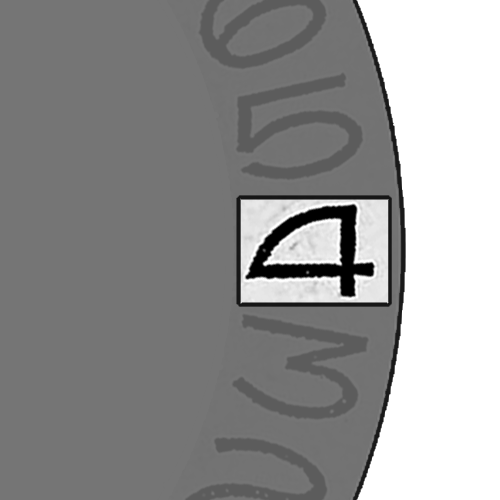
The Date Wheel - Changes over the Years
A history of changes to the Date Wheels on SEIKO World Time mechanical watches from 1964 through 1976

The Dial - Changes over the Years
A history of changes to the Dials on SEIKO World Time mechanical watches from 1964 through 1976
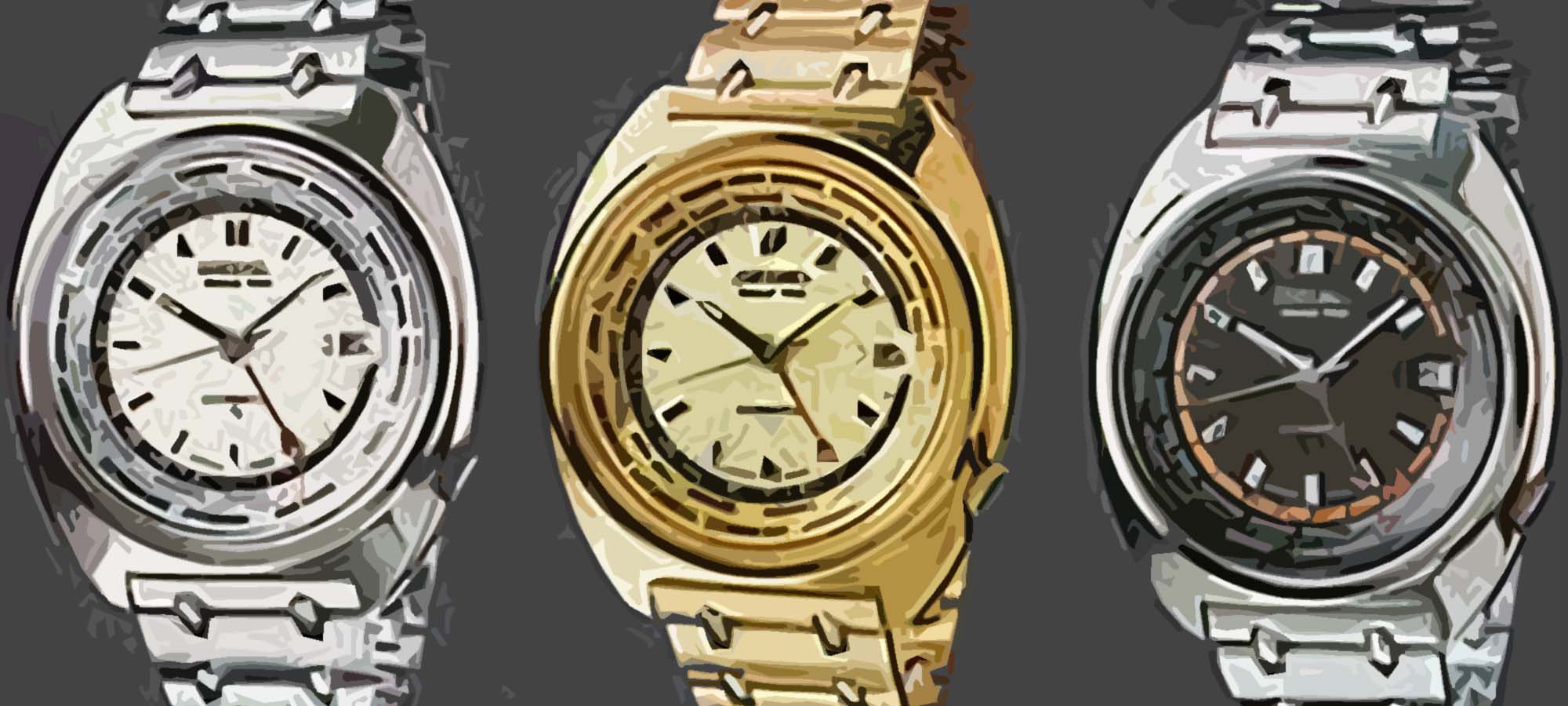
The Seiko World Time 6117-6409 in Gold
All about the gold/gilt world time watch from SEIKO, produced in 1972

The Seiko World Time 6217-7000 - 1967
All about the reproduction of the first series world time watch from SEIKO in 1967
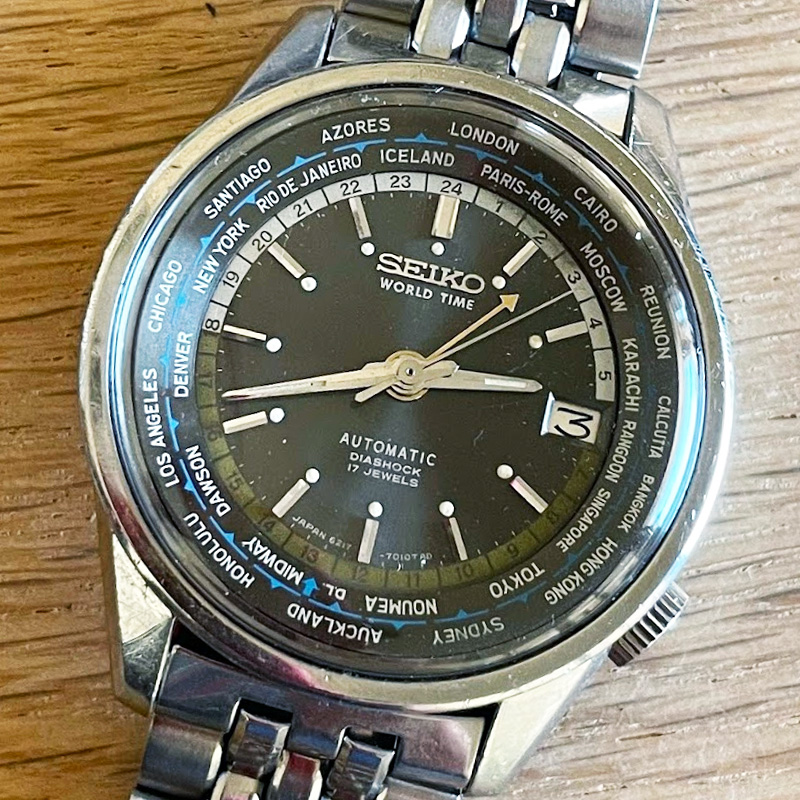
The Seiko World Time 6217-7010 - Standard Edition
All about the 2nd Series World Time watch from SEIKO in 1967